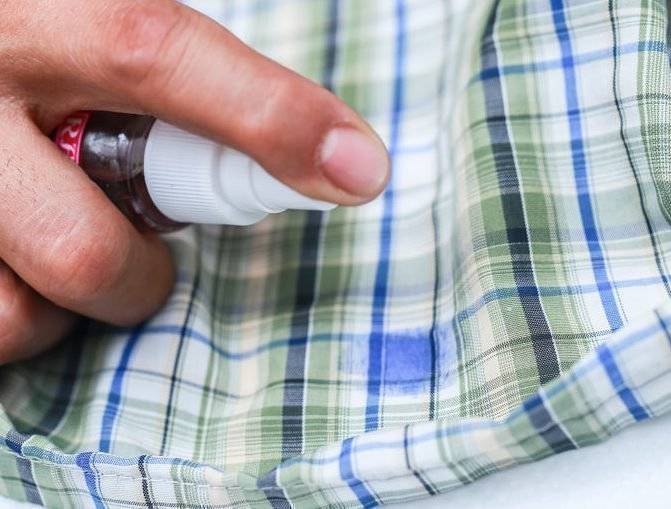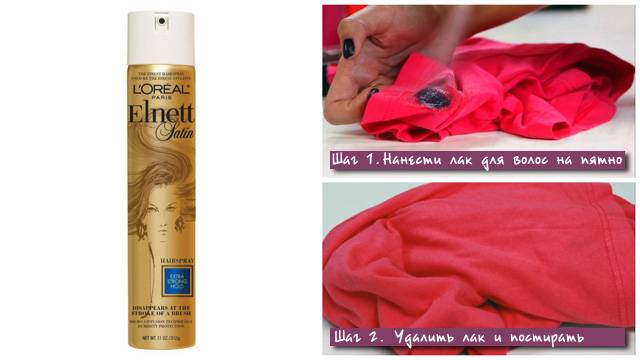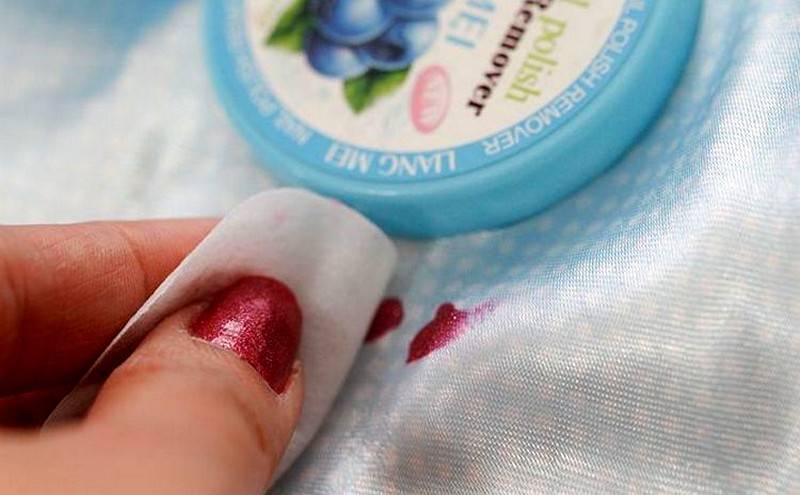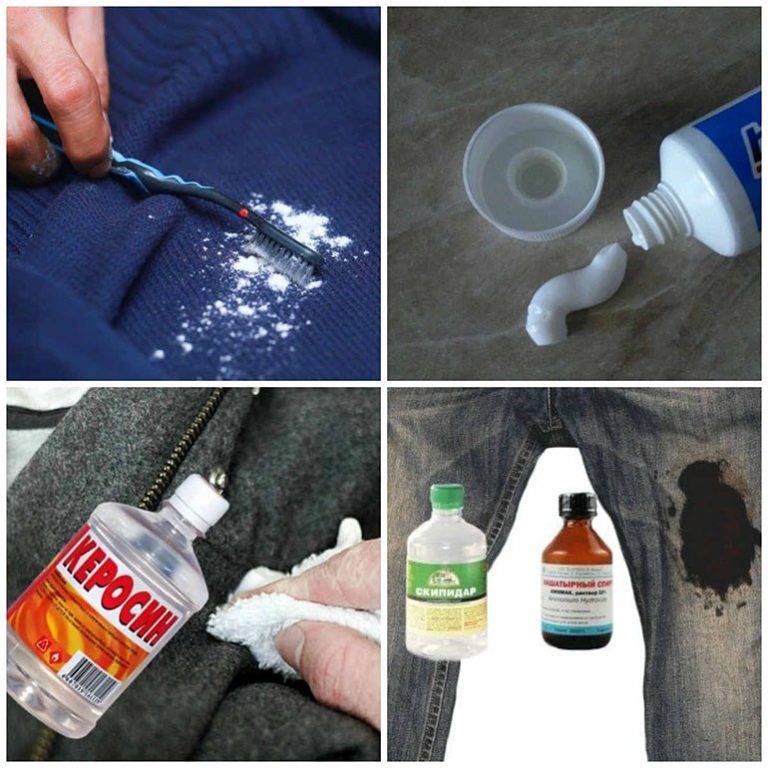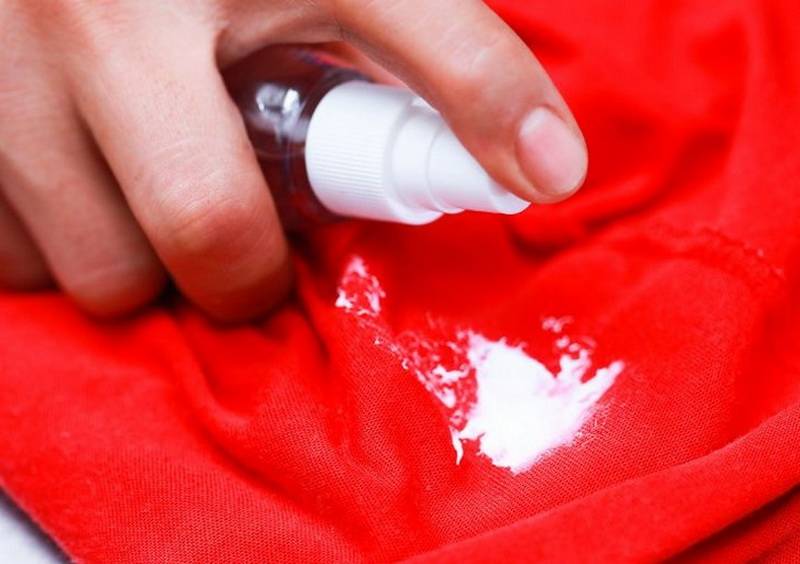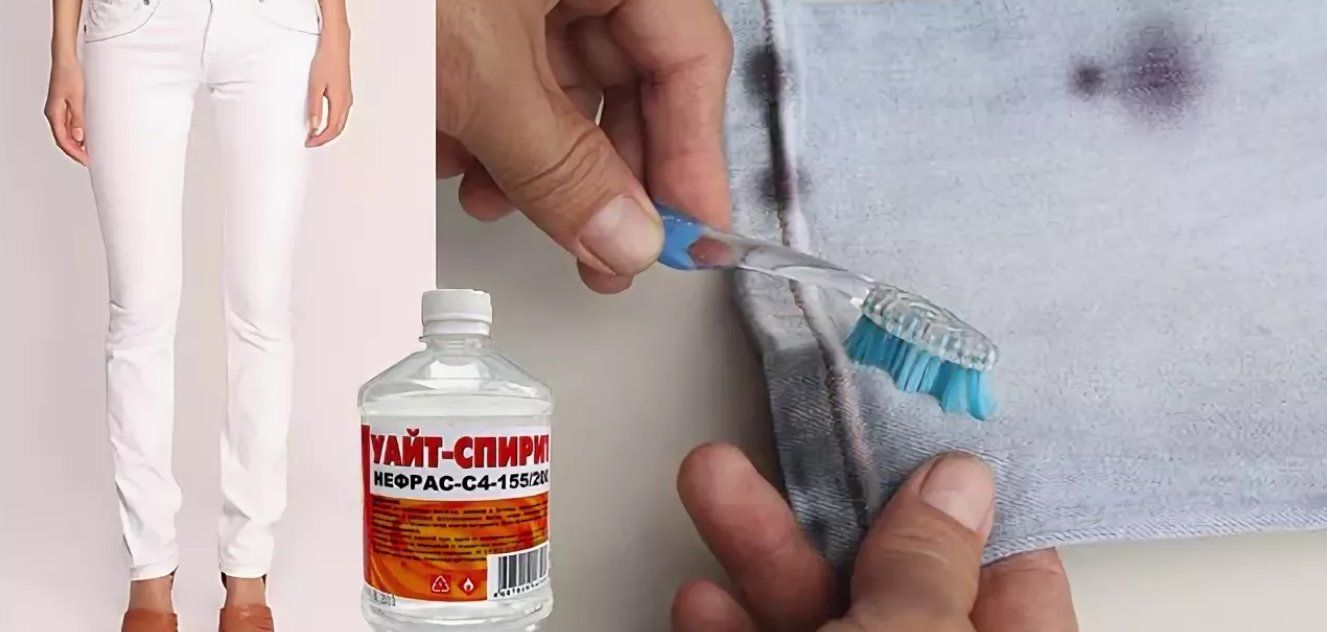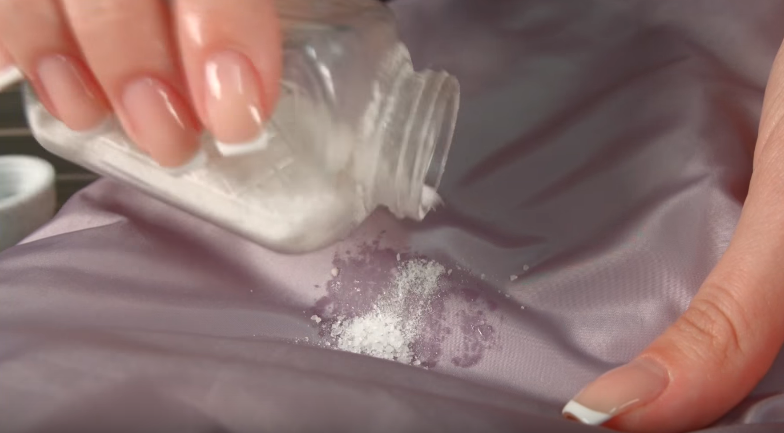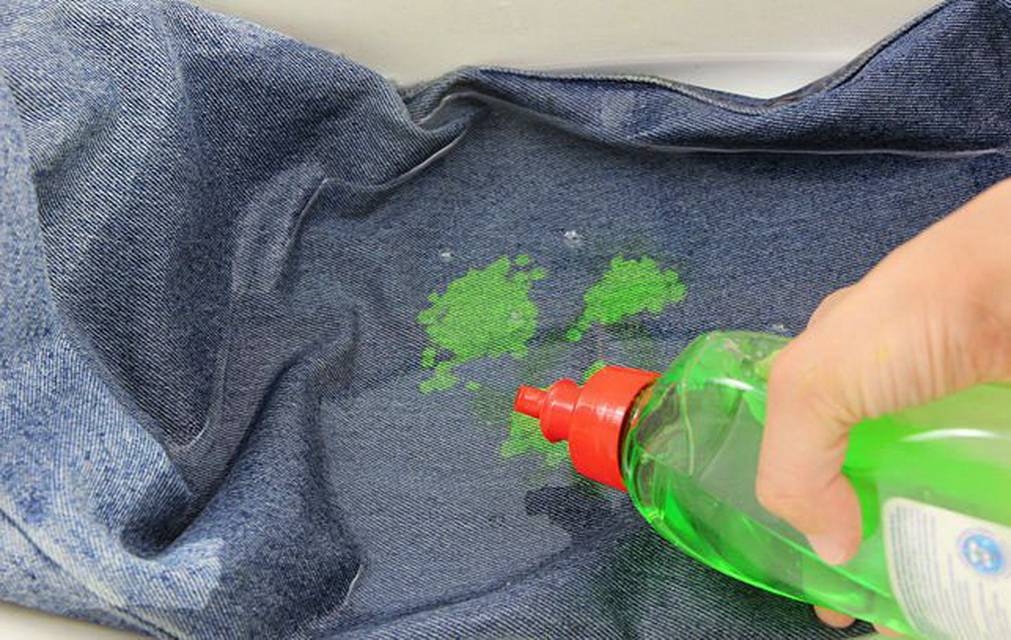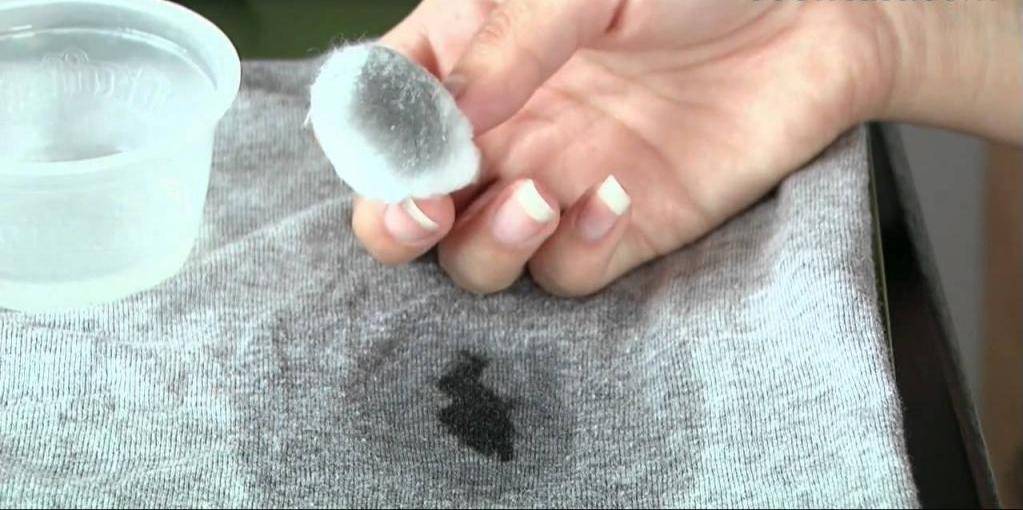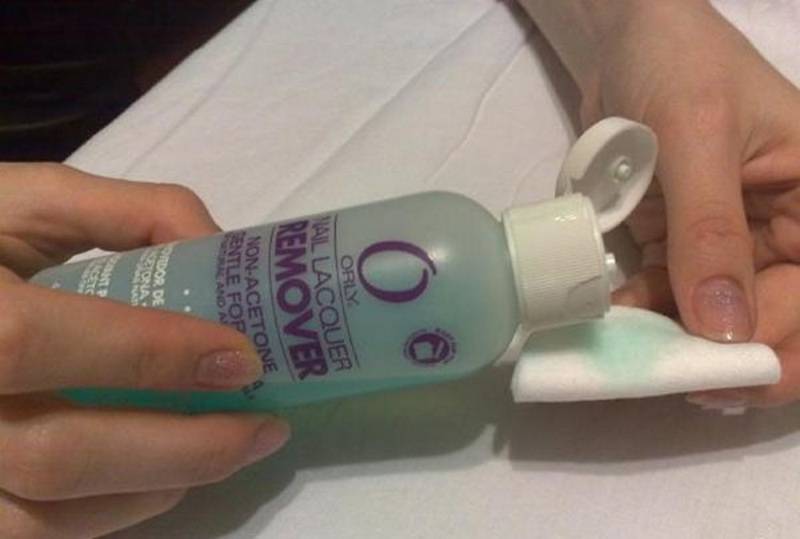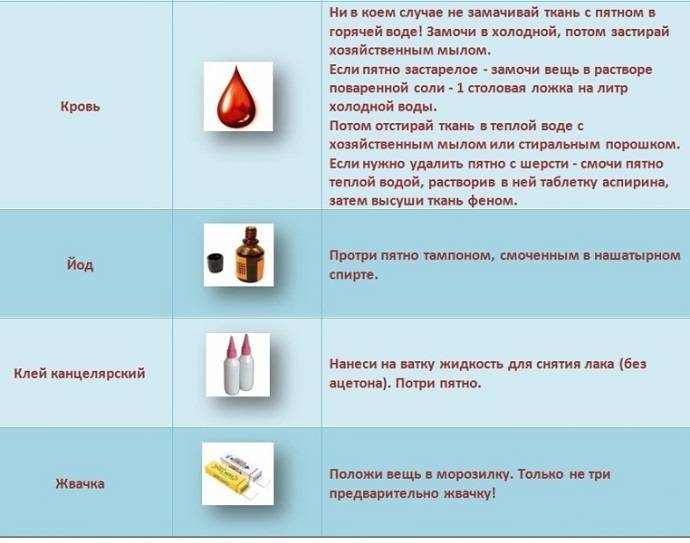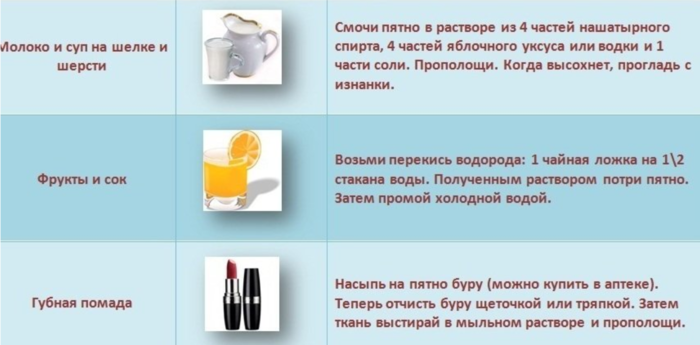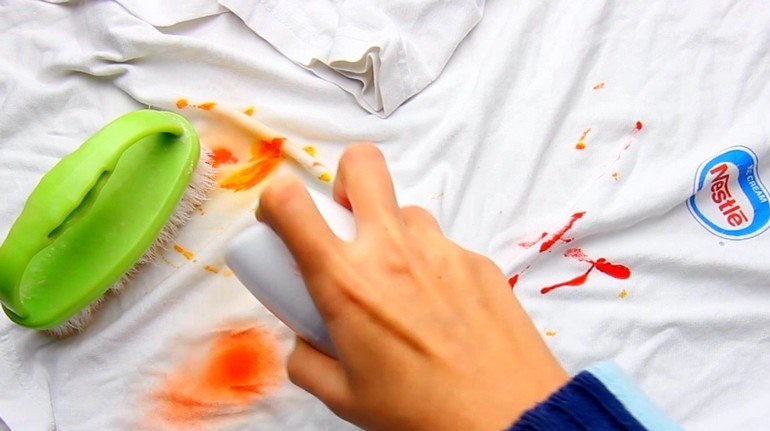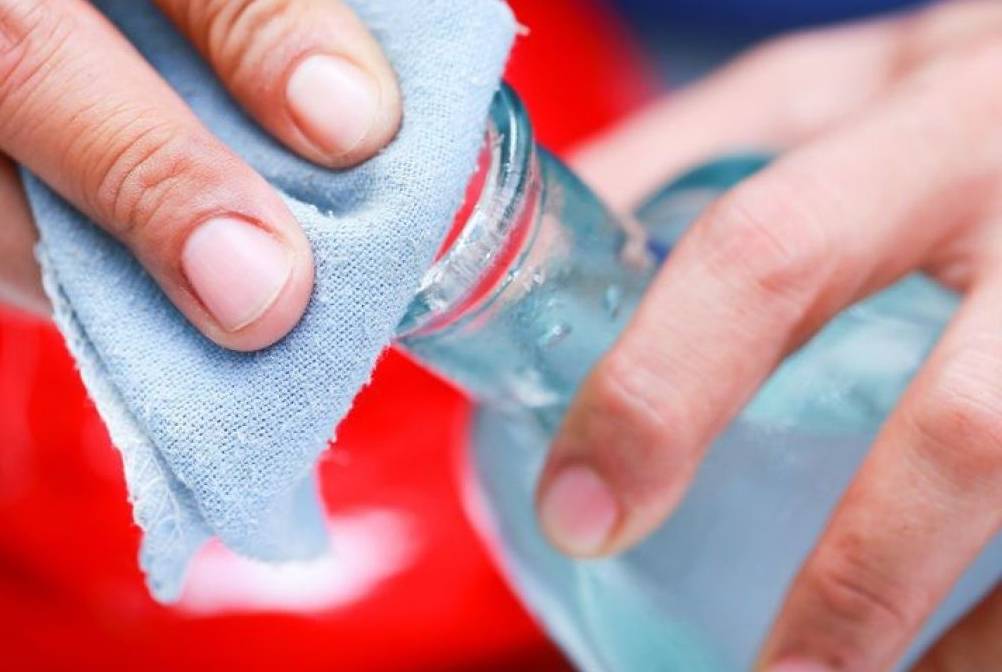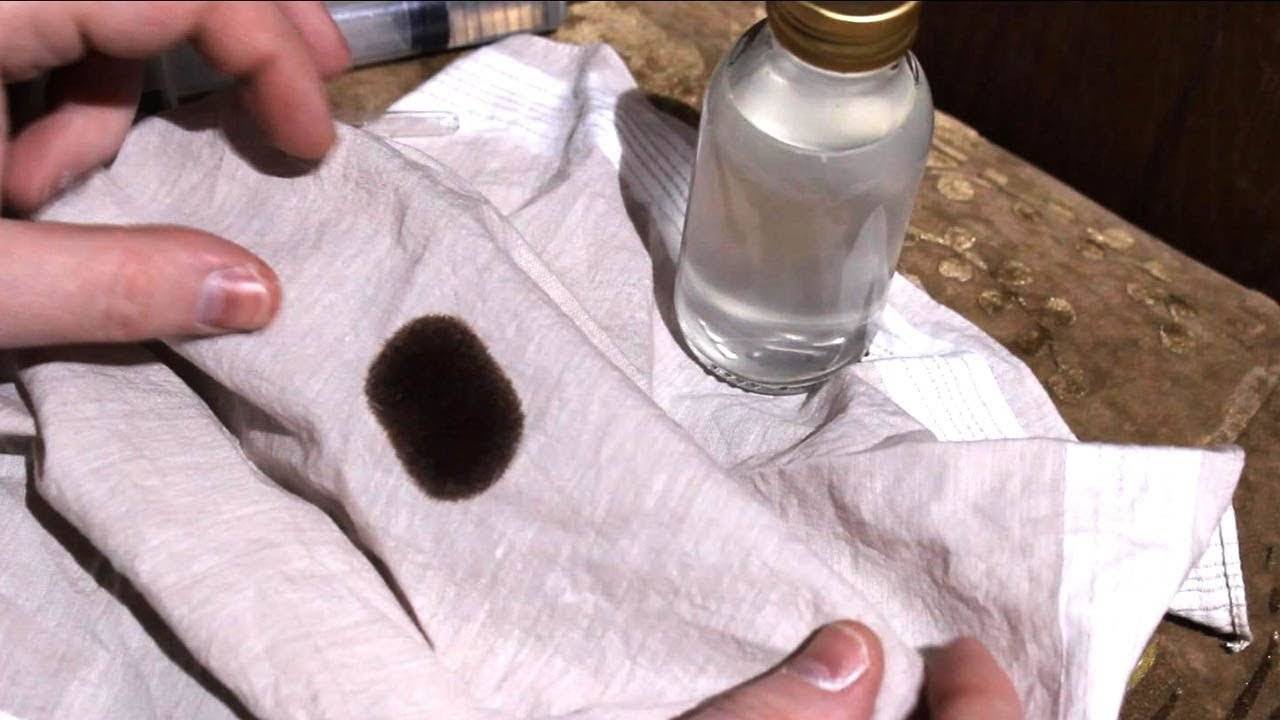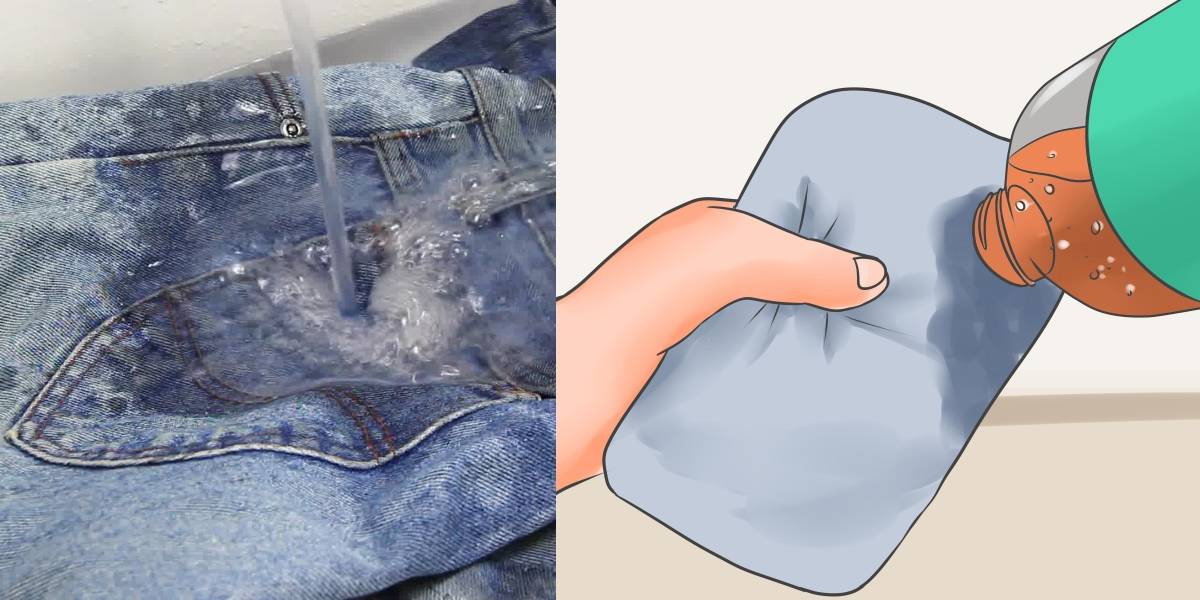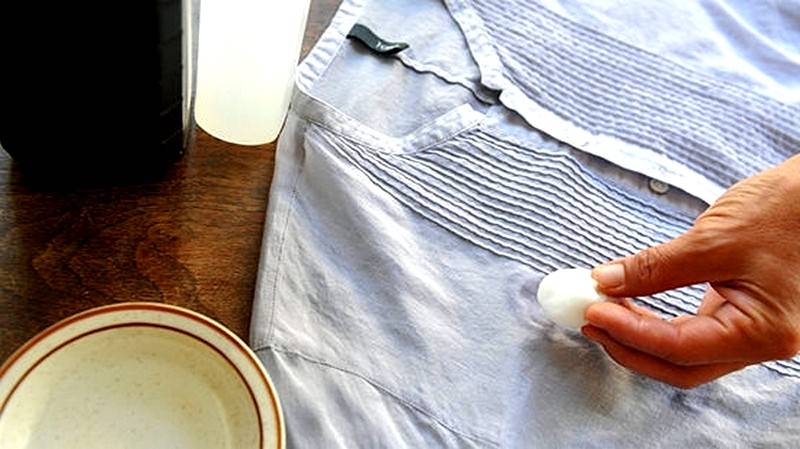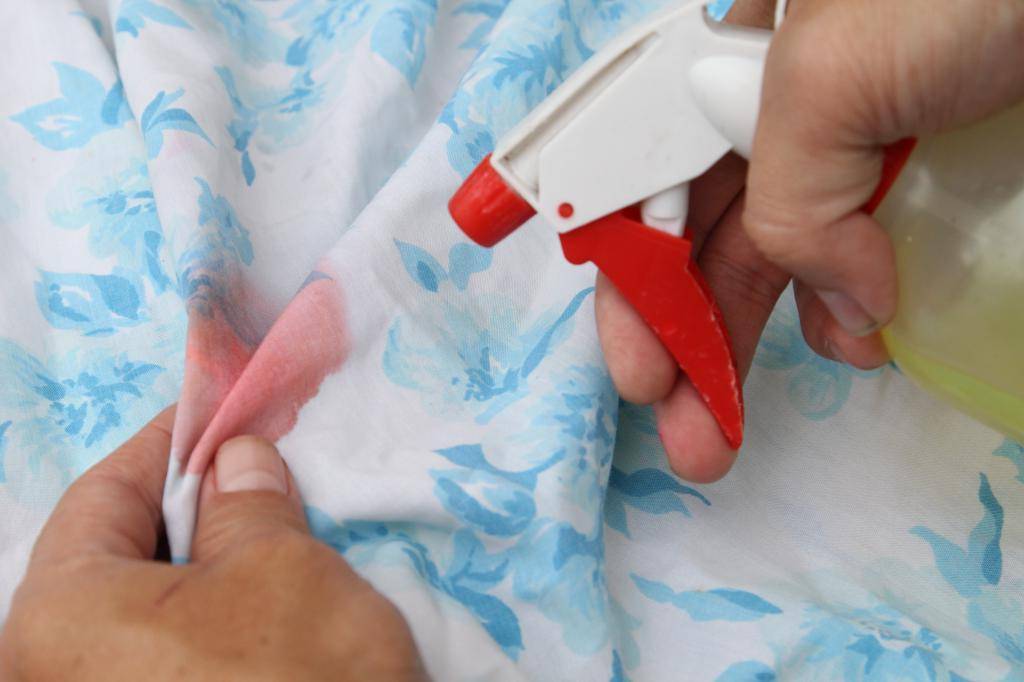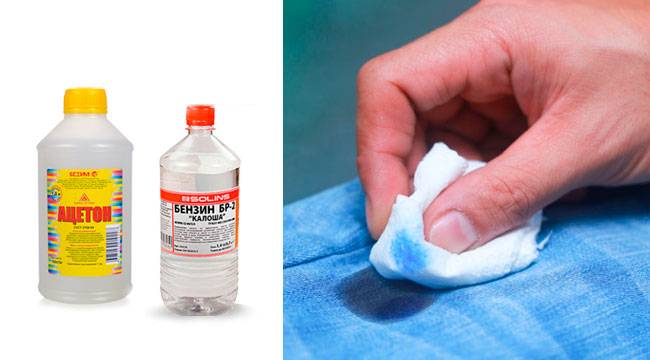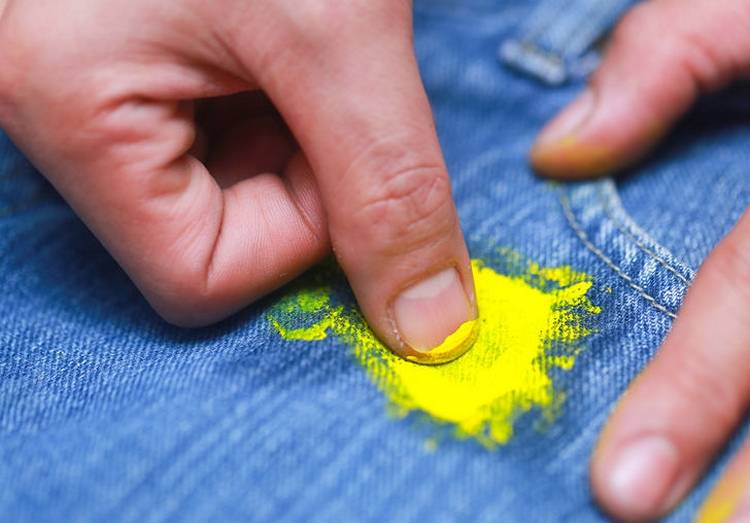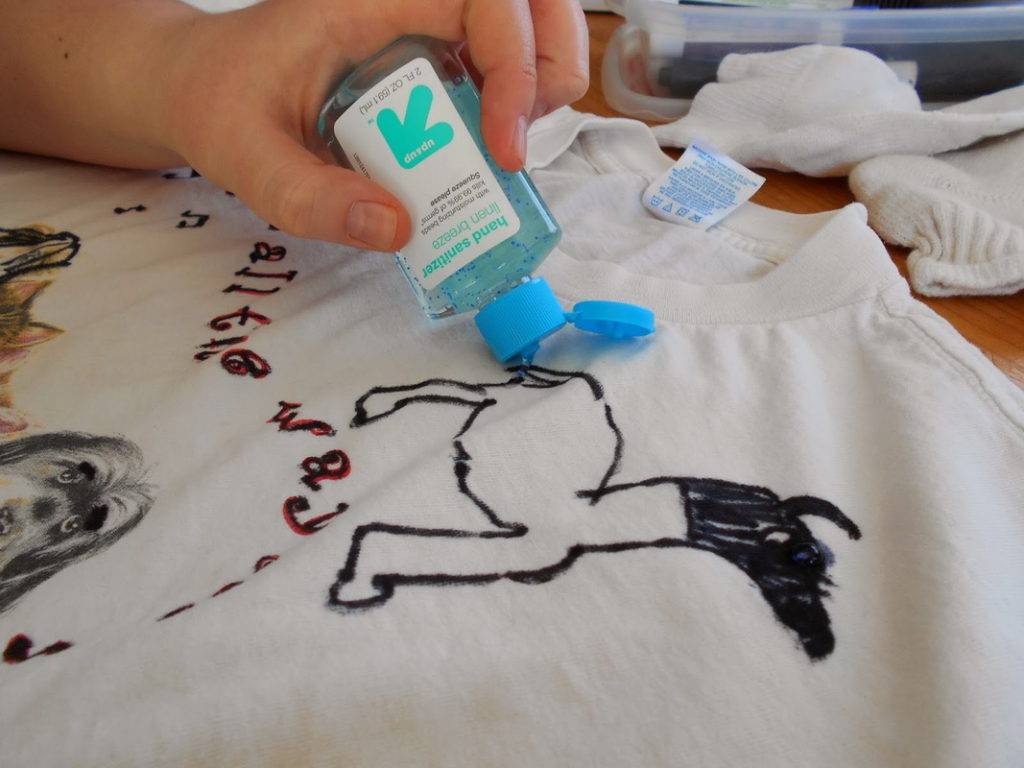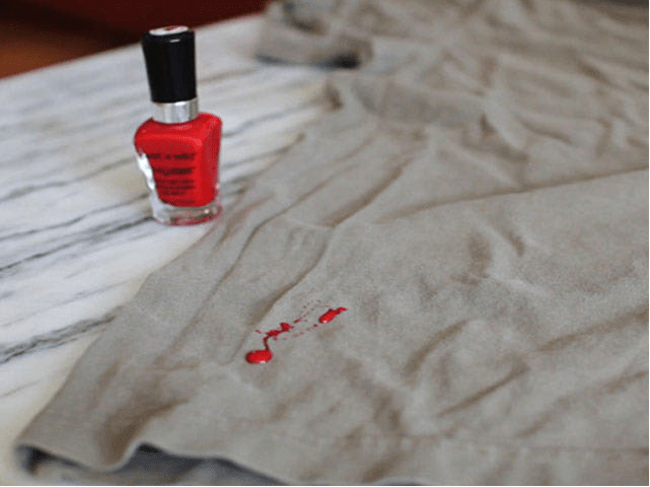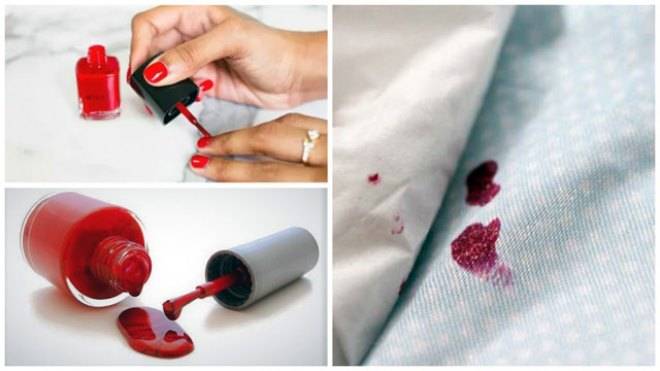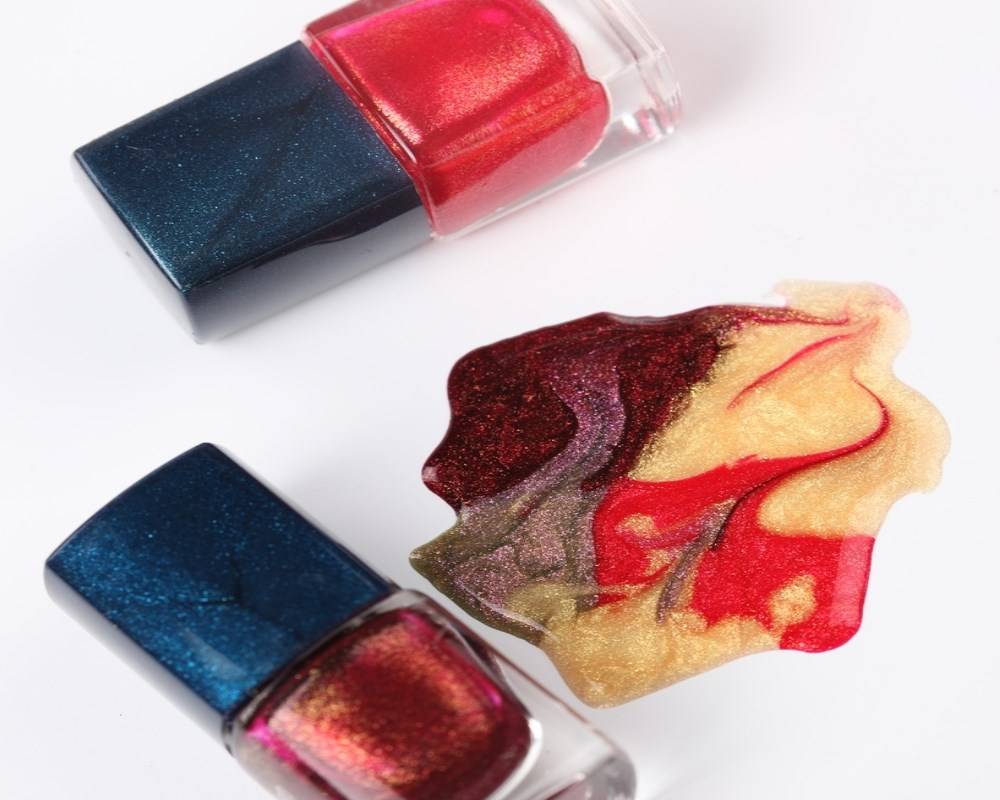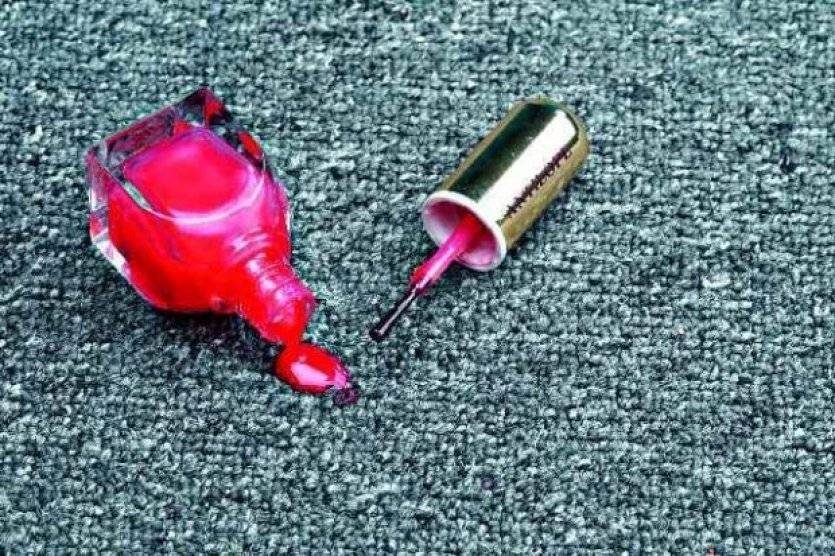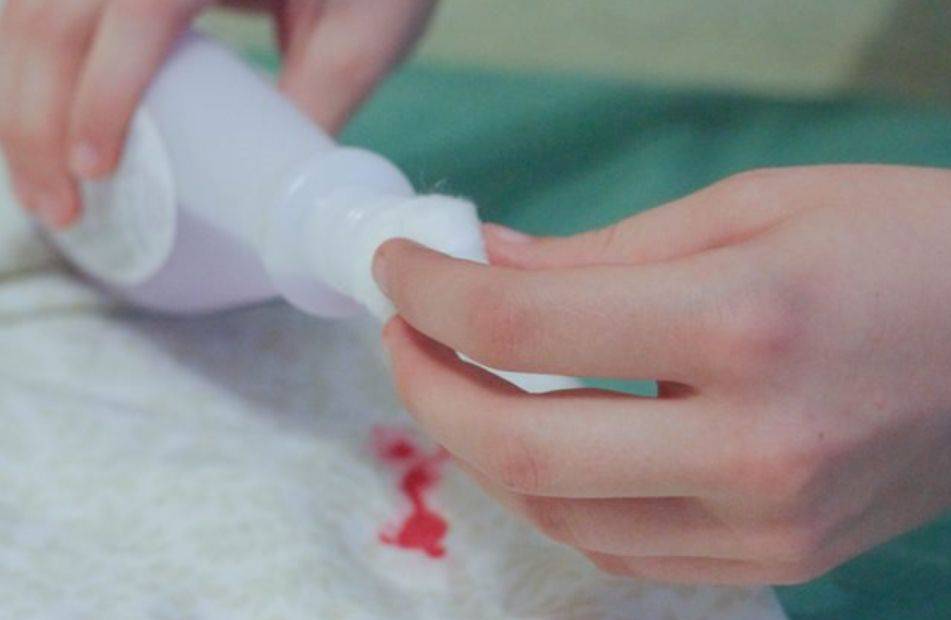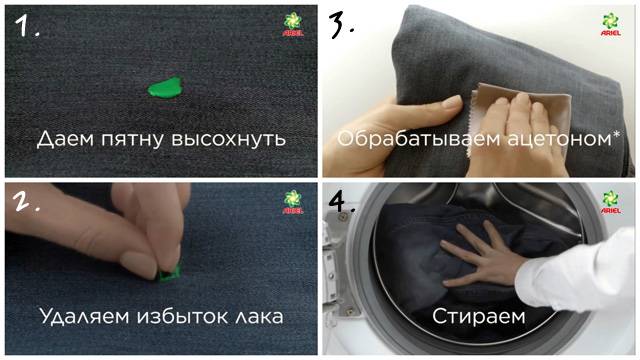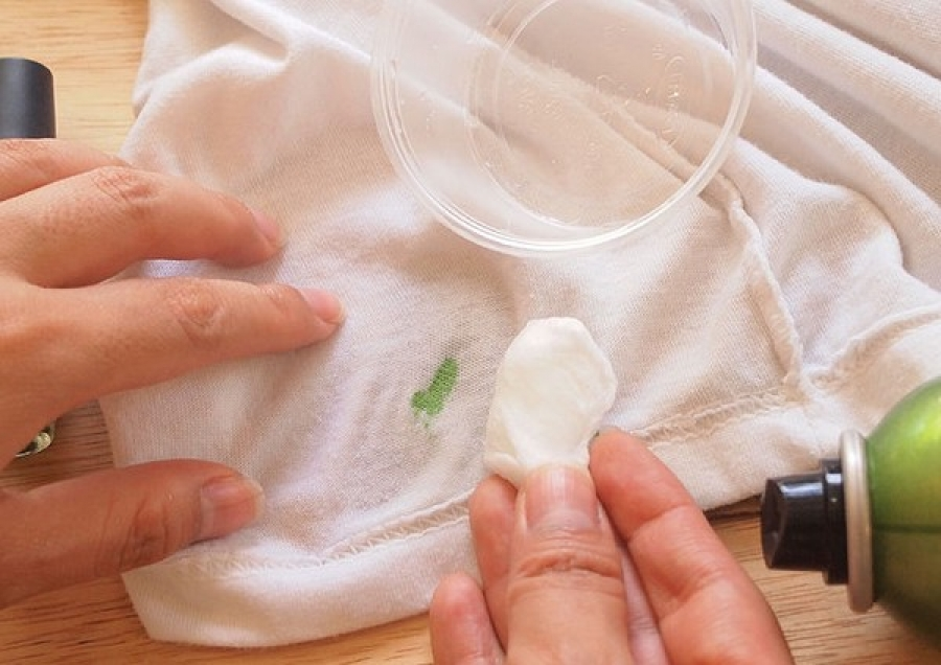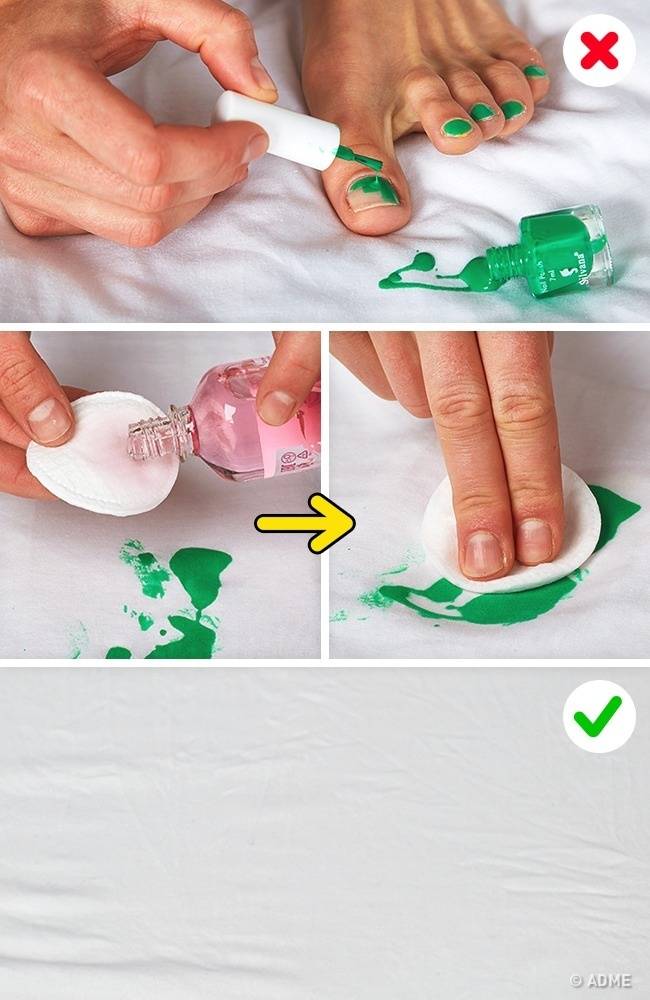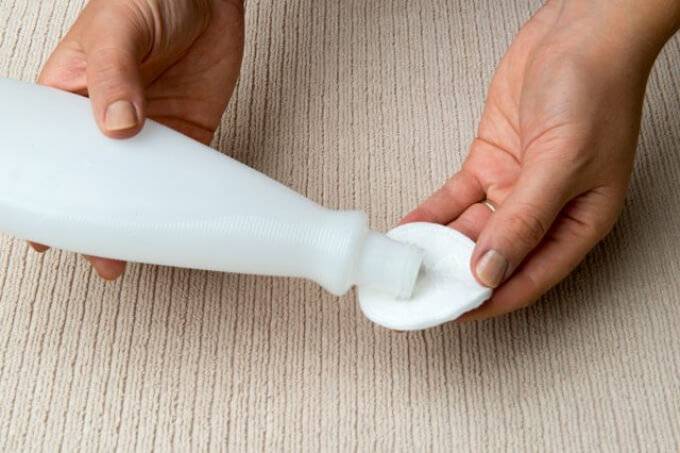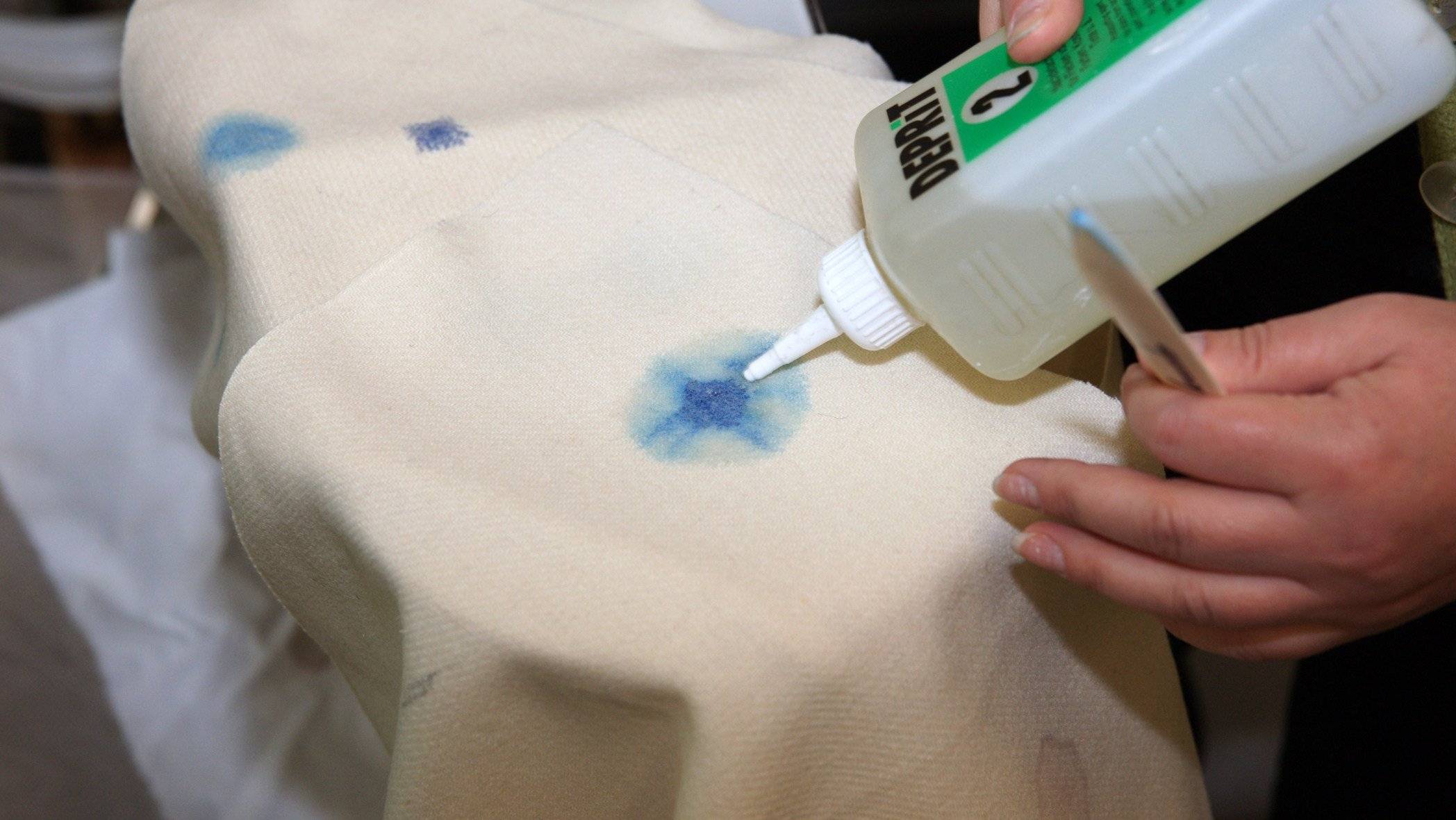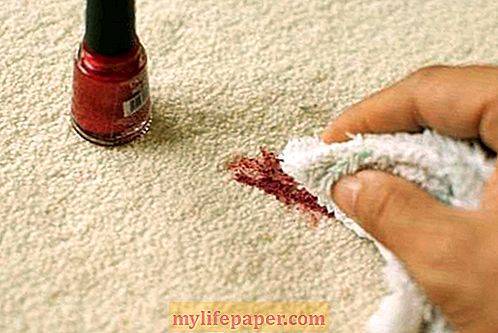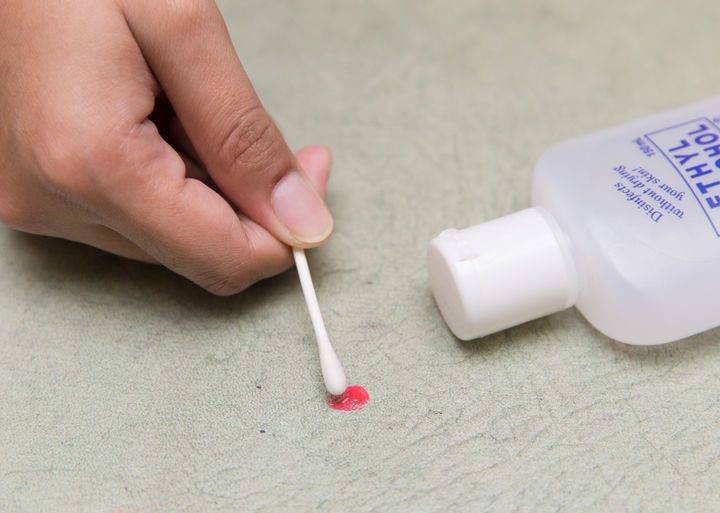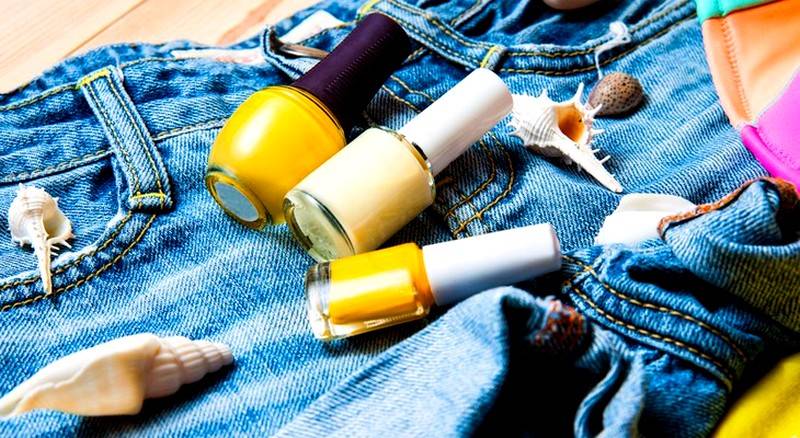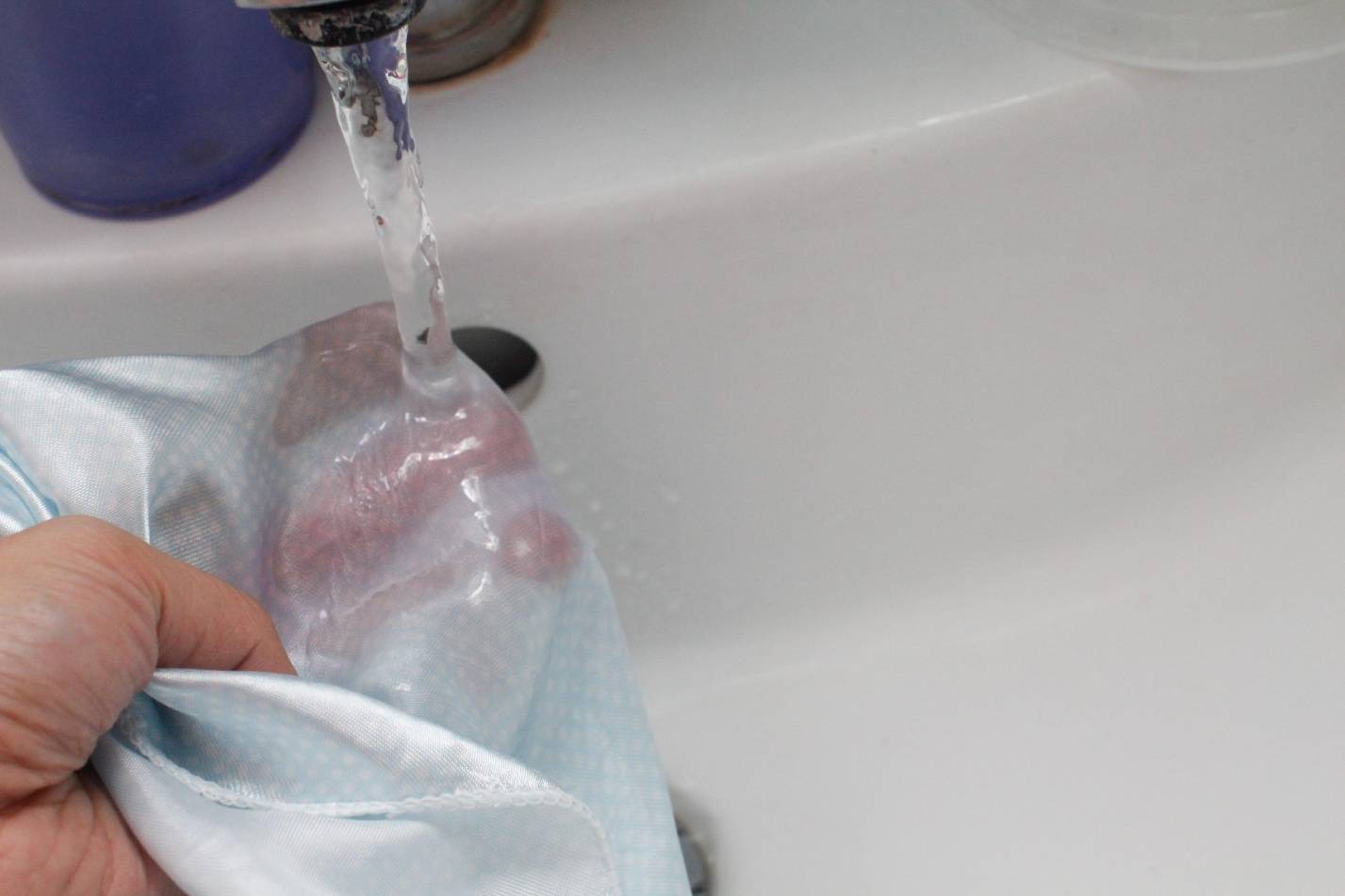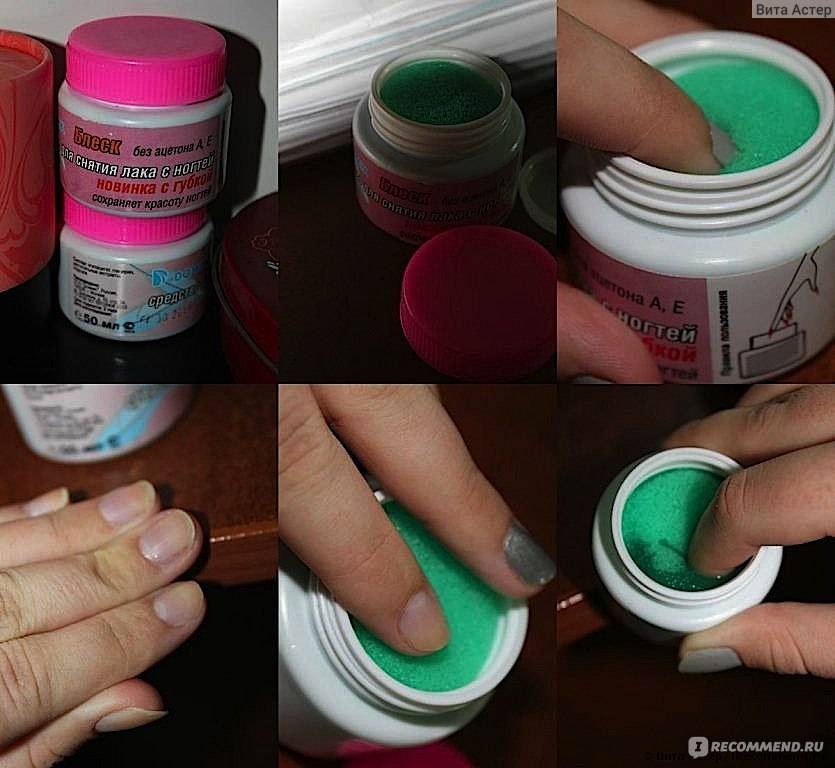What to do before deleting
If a large amount of varnish has got on the fabric, preparatory procedures must be carried out before removing the stain. This is recommended in order to make the further paint removal process more efficient. Usually, in such cases, the following is done:
Blot the damaged area with a cotton swab, paper towel, washcloth - everything that has an increased level of hygroscopicity. This must be done carefully, without rubbing the stain or pressing on the surface.
Continue until the excess varnish is removed.
Use a sharp object, for example, a fine toothpick (you can try a toothbrush, but be careful) to loosen the structure of the fabric, while collecting the particles of varnish.
Spread out a clean white cotton cloth (in the absence of, the same paper towel will do) and put clothes on it, soiled side down. Straighten the fabric.
Preparation should be carried out before the procedure.
Nail polish remover
Aggressive acetone is effectively used to remove varnish from white and colored fabrics.
The product cleaning process consists of the following steps:
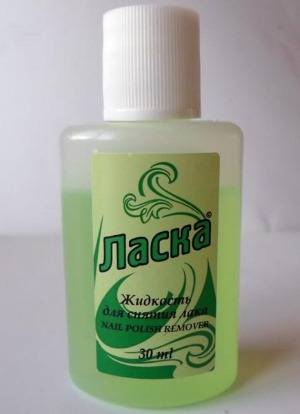
- Soak a cotton swab in liquid.
- Gently wipe the varnish, trying to get the droplets out of the depths of the fibers.
- Wash clothes with powder.
- Dry.
The technique has a minor drawback - a sufficiently long period is required to eliminate the problem.
Acetone will do well with the problem. To do this, you need to drip liquid from a pipette onto the stain, and after 5-10 minutes. wipe with dry wet wipes.
But, after acetone, stains remain on the fabric, so be sure to sprinkle with talcum powder or baby powder, leaving the powder for 5-7 minutes. Then treat the stain with a stain remover.
Modern stain removers
Of course, no one belittles the merits of modern household chemicals.
Those who are wary of folk methods can be advised to go to the nearest supermarket and find the right product there.
Further - actions according to the instructions. As a rule, each of them includes the following stages:
- Remove the remaining dried varnish with a razor blade or knife. This should be done as carefully as possible: one awkward movement and a hole will gap in the spot.
- Treat with the purchased product the remains of the varnish that have stuck into the fabric.
- Leave the thing for a few minutes.
- The last step is machine wash.
What can be erased from clothes
For those who do not know how to remove nail polish from fabric, below are the tools that can easily cope with this kind of pollution.
Nail polish remover
 This is the first thing that comes to mind when the question arises of how to remove varnish from clothes. This is logical, but only for natural fabrics. The exception is leather and suede. The solvent for nail polish remover corrodes synthetics, therefore it is unacceptable to use it on this material.
This is the first thing that comes to mind when the question arises of how to remove varnish from clothes. This is logical, but only for natural fabrics. The exception is leather and suede. The solvent for nail polish remover corrodes synthetics, therefore it is unacceptable to use it on this material.
First, put the soiled thing on a paper towel, then take a cotton swab, disk or small sponge, moisten it abundantly with liquid and rub gently into the stain without touching the clean areas of the fabric. Allow the varnish thinner to absorb and dry for 20 minutes. After that, it is enough to wash things using dish detergent instead of powder.
Artificial fabrics should be cleaned with acetone-free nail polish remover to avoid ruining the item.
Bleach, gasoline and peroxide
All of these can also be used as a nail polish remover from clothes.
- You can use hydrogen peroxide to wipe stains off white clothing.To do this, moisten a cotton pad or a piece of cotton cloth with peroxide and thoroughly treat the stain, and then wash the item by hand.
- Gasoline and white spirit can be used on synthetics and jeans as they are less aggressive than others. To remove the lacquer mark from clothes, you need to apply a solvent or gasoline to it and try to clean the stain with an unnecessary toothbrush. To remove stains on white or light colored fabrics, mix thinner or gasoline with chalk or toothpaste. After applying solvents to the fabric, you need to wait a while, and then rinse the item in cool water and wash it by hand after 20 minutes. If the stain fails, you can try repeating the process.
- You can use regular stain remover or bleach to remove gel polish stains from white clothing. A small amount of the solution must be poured onto the stain and left for 15 minutes, after which simply wash the clothes. It is best to use chlorine-free products because chlorine can damage fabrics.
Cosmetic and hygiene products
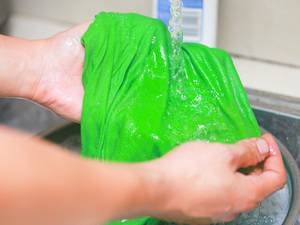 You can use insect repellent. The ingredients that make up the repellents are able to remove varnish stains from any fabric (including jeans and covers of sofas and armchairs), just spray the liquid on the area stained with varnish and wait a few minutes, then rinse the product along with the stain in cold water.
You can use insect repellent. The ingredients that make up the repellents are able to remove varnish stains from any fabric (including jeans and covers of sofas and armchairs), just spray the liquid on the area stained with varnish and wait a few minutes, then rinse the product along with the stain in cold water.
Hair styler is also a good remover of nail polish stains. Spray a large amount of styling product onto the dirt and leave it on for a while to absorb. After that, traces of varnish can be removed using an unnecessary brush. You should try to spray hairspray exclusively on the stain, without getting on clean areas, so as not to damage the clean fabric.
You can also use regular toothpaste to wipe away any nail marks. To do this, mix it with sunflower oil in equal proportions to get a homogeneous gruel. Apply the resulting product to the dirt and leave to dry. After that, thoroughly clean the mixture with dirt and wash the item in cool water.
Glycerol
You can use glycerin to remove traces of varnish containing aluminum particles. It must be gently applied with a cotton swab to the dirt. Then briefly soak the item in water with dissolved powder and wash.
Alternative methods
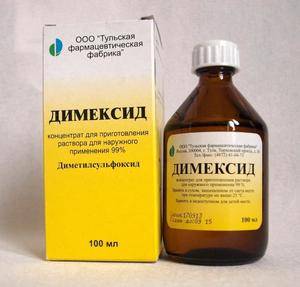 If a trace of fresh manicure remains on a woolen thing with a long nap, you can leave it until it dries completely and then try to cut off the soiled fibers with scissors.
If a trace of fresh manicure remains on a woolen thing with a long nap, you can leave it until it dries completely and then try to cut off the soiled fibers with scissors.
You can also make your own product to wipe the nail polish off your clothes. To do this, it is necessary to mix in equal proportions olive oil, ammonia and turpentine. Gently treat the stained area with the resulting mixture and wait 10-15 minutes. After that, wash the item as usual.
A small trace of nail polish can be removed without any means. If the stain is very dry, you need to grease it with ordinary laundry soap or butter, leave it for 30 minutes and try to wipe off the varnish with a knife or a coarse-bristled brush. This method can also be used to remove varnish stains from furniture: sofa, armchairs, etc.
How to wipe nail polish off clothes with household chemicals
On the market today, you can find many convenient and easy-to-use products designed to remove stains from various types of materials. To remove the varnish, you need to perform a number of actions:
- Remove excess material from clothing with a sharp blade, taking care not to damage the material.
- Apply the selected product to the stain.
- Leave for the amount of time indicated on the package.
- Immerse the garment in the washing machine and select the mode suitable for the type of fabric.
- Dry the laundry and, if necessary, repeat the described procedures.
If the choice fell on a stain remover pencil, then its use differs from similar means only in that it is necessary to rub the contaminated area with a pencil and wash it after 20 minutes.
In addition to stain removers, there are other household chemicals that can remove dirt. It is hairspray and insect repellent.
Hair styler can be used as follows:
- Spray hairspray on an old toothbrush.
- Treat the contaminated area in a circular motion.
- After the dyed fibers peel off, the varnish will disappear.
- At the end, you just need to wipe the thing with a wet sponge and rinse it so that the particles of hairspray and nails completely disappear.
Insect poison, such as dichlorvos, does an excellent job not only for flies, but also for all types of stains, and will also help wipe the varnish from jeans and remove color pigment from furniture upholstery.
- Spray the selected product on the stained area.
- Apply it to your old toothbrush as well.
- Rub the dirt with it until it disappears completely.
- Rinse and wash clothes.
Universal ways
These techniques are suitable for both natural and non-natural fabrics.
Hair fixation spray
Instructions:
-
We apply varnish to the place of pollution.
- Let it dry.
- With an old toothbrush, we brush off the remains of the varnish together with the dye.
- We erase it in the usual way.
Repellent
It is best to take the insect repellent in the form of a spray.
Instructions:
- Spray on the trace of the varnish.
- We are waiting for drying.
- Rinse the item in cold water.
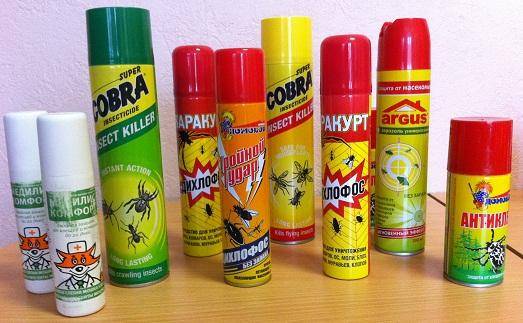
The repellent dries the varnish layer and can be easily removed from the textile surface
Scissors
If we are talking about stains on woolen items or long-piled carpet, then you can simply cut off the dirty fibers. Of course, this method is unacceptable if the stain has penetrated deep into the fibers, and your plans are not to be the owner of a bald carpet.
Toothpaste
Instructions:
-
We mix the paste with sunflower oil until the consistency of gruel.
- Apply to the stain (s).
- Let it dry and wash off.
Nuances when stripping
Often, an incorrectly performed procedure leads to the fact that damage to the product remains. Then you have to say goodbye to your favorite thing. To prevent this from happening, it is necessary to carefully prepare for the removal of the stain, select the appropriate substances. Be sure to check the effect of the reagent on the fabric by applying it on the back of the product or where it is not visible. Rub the stain from the edges to its middle. If the spots are small, then the cleansers are applied using a pipette or brush.
Fresh stains
When tar stain immediately detected, then it is easier to remove it by lubricating:
- vegetable oil for softening;
- thick dishwashing gel;
- alcohol;
- coca cola;
- turpentine.
After holding the selected substance on drops of resin from half an hour to an hour, wash the product with laundry soap, and then place it in a typewriter.
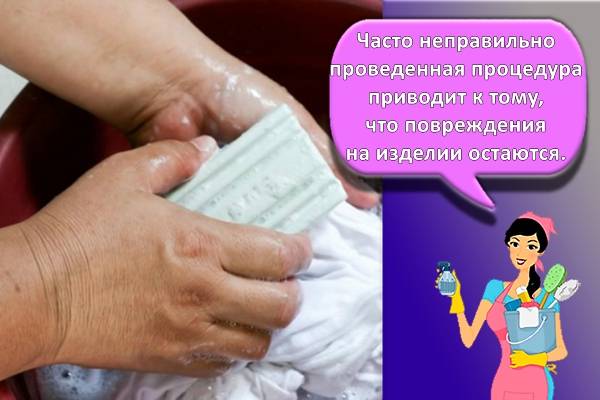
Aged tar blots
More aggressive products are suitable for older stains. These include turpentine, ammonia, gasoline. Use different methods to eliminate contamination. Dense fabrics need strong chemicals, silk fabrics need gentle techniques. For them, it would be better to use gasoline with laundry soap, starch paste, stain remover.
Epoxy stains
You can try to remove the epoxy from the stain. First, they act on it mechanically, scraping with a spatula or spoon. Then, a solvent based on acetone or alcohol is poured onto the damaged area. It is necessary to withstand 10-15 minutes, then wash the product.
Tar is very similar to resin in its viscosity. And here you have to work for a long time to get rid of the black blot on your clothes. White clay is mixed with starch, the mixture is diluted with turpentine and ammonia. The gruel is applied to the stain, leaving it for 20-30 minutes.When the powder is dry, brush it off. Yellowish stains will remain, but they are carried out with a cotton pad dipped in hydrogen peroxide.
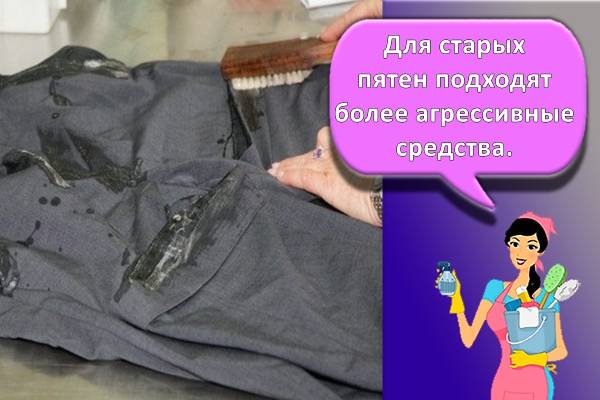
If the varnish has dried
If the dirt is old, you need to saturate the fabric with moisture along with the stain. To do this, mix the washing powder with sunflower oil, apply it to the surface. Then you need to clean the top layer of varnish with a blade, knife or nail file and look at the label. Depending on the material, a method is selected:
- Cotton. We mix clay with gasoline, apply to the surface. After a couple of hours, the clay absorbs the dirt, we clean it and the stain becomes barely noticeable. Then you can try the rest of the methods.
- Synthetics. Salt water and ammonia will help. The latter penetrates into the structure of the fibers and destroys the base of the varnish. After three cotton swab dipped in alcohol from the edges to the center of the pollution.
- Wool. For a woolen sweater, you will need alcohol and laundry soap. We heat up and mix the first with the second. Then we dip a sponge, three from the edges to the center. Alcohol penetrates well into the composition of the wool, removing the main pollution.
After preliminary cleaning, drip gasoline onto the stain, wait 15 minutes. For white clothes, mix gasoline with chalk. Clothes can be washed after the procedure. You cannot rub the stain with gasoline, it will become larger, only dripping is allowed. For large surfaces we use acetone.
Attention! Acetone eats away at synthetic fabrics!
Before using, sprinkle the edges with starch so that there are no streaks. Then we moisten the cotton swab with acetone and clean the area. After the procedure, we wash clothes in warm water, add a stain remover if desired. Denatured alcohol can be mixed with acetone for better color retention.
Tips for getting rid of stains
There are a number of tips to follow when dealing with a blemish problem:
- It is necessary to wash the product only after removing the dirt. Otherwise, the wet varnish may run out and the stain size will increase. After that, even dry cleaning will not be able to return the original look to the product.
- Before starting to remove traces of varnish from a thing using any means, it is necessary to establish the type of material from which it is made.
- Before use, test the substance used to remove contamination on an inconspicuous part of the garment (ideally on the inner seam to ensure that the fabric does not fade, discolor or change its texture).
- Do not use acetic and citric acid to remove varnish. The result of their aggressive effect on tissues can be a change in their color and destruction of the structure.
- Handle solvents and bleaches in a well-ventilated area. To protect the skin of your hands, you need to use household gloves.
- The described methods can be used to remove gel polish.
- If the soiled item is expensive, you should seek the help of a dry cleaner.
How to remove nail polish stains from natural fabrics
Natural linen, wool, cotton materials withstand strong solvents.
Acetone. We saturate a cotton swab with it and wipe off the lacquer trace. You may need to repeat the treatment after rinsing. When the contamination disappears, sprinkle the affected area with talcum powder while still wet. In an hour, we send the product to the wash.
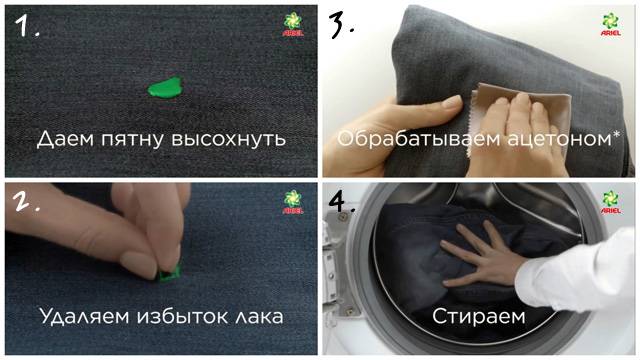
Hydrogen peroxide. If the coating is light-colored, turn to hydrogen peroxide. Take a small textile napkin, moisten it with the preparation and put it on the spot. After a while, check the effect. If the contamination has not disappeared, the procedure is repeated. You can use cotton swabs for removal, which are dipped in peroxide and gently remove the varnish mark.
Petrol. Before wiping the varnish off the clothes, pour some refined gasoline onto the mark. You can moisten a cotton ball and put it on the stain.As it dries, the swab is moistened. If a lot of lacquer particles have been absorbed, take a fresh swab and repeat the procedure until the trace disappears.
Gasoline with chalk. If the thing is white, crushed chalk is added to the gasoline. The resulting gruel is kept on the affected area until dry. Take an old toothbrush to wipe off any particles.
White Spirit. To guarantee the dissolution of the varnish mark, the tissue flap is dipped in white spirit and placed on the desired area. After 20 minutes, the marks are removed with a brush. Clean the marks off the fabric by wiping the stain with a cotton pad soaked in solvent from the edges towards the center.
"White". When removing lacquer prints, "Whiteness" drips from white things, trying to capture only the area of contamination. Stand for 40 minutes.
By correctly choosing a type of cleaning composition, you can return the products to their original appearance without deforming the fibers. Strong friction is contraindicated in denim products, which can cause whitish stains.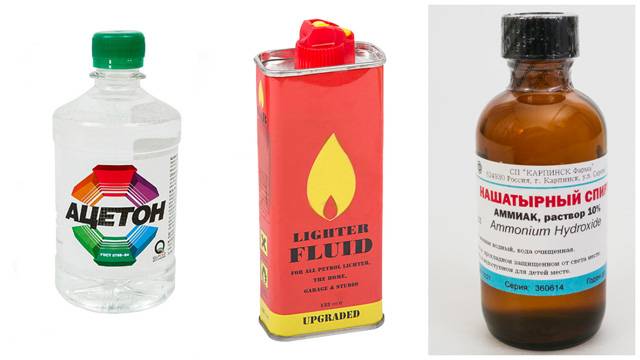
Hydrogen peroxide or "Chlorhexidine"
It is used only for cleaning varnish stains on light-colored fabrics. Since the product whitens the product.
You will need: cotton pads, hydrogen peroxide or "Chlorhexidine" (6% solution), baby cream or sunflower oil.
We take two cotton pads. The first one is moistened in a solution of peroxide or "Chlohexidine" and applied to the varnish stain, on the second one apply baby cream or oil, place from the inside out. We fix everything and hold it for 20-30 minutes. We remove the cotton pads, while the varnish should soften, carefully erase it with a blunt object, without smearing the stain.
Here are some tips to help you:
- Before cleaning, check the selected product on an inconspicuous area of clothing (seam bend, pocket lapel). It is enough to drip a little and wait about 20 minutes. If the stain has not changed, then you can try to clean it.
- Use cotton pads to clean stains, do not let the product come into direct contact with the fabric.
- Do not use solvent for cleaning natural and artificial leather. Stains and blisters will remain.
- Use warm glycerin to clean delicate fabrics.
- Try different ways of cleaning your clothes from nail polish at home.
In extreme cases, it is better to go to a dry cleaner.
Acetone
The easiest and most effective way to remove traces is acetone. It is more likely to damage synthetic fabrics, so it is recommended to use it if you get dirt on a thing made of natural material.
Place a white rag under the stained area, rolling it up several times. Pour a small amount of acetone onto a cotton ball or directly over the stain and rub gently on the desired area.
If after acetone there are stains on the fabric, treat them with a sponge or cotton swab dipped in gasoline. After that, sprinkle some dry baby powder on top, and after an hour try to remove the remaining traces of dirt with a regular detergent.
How to proceed
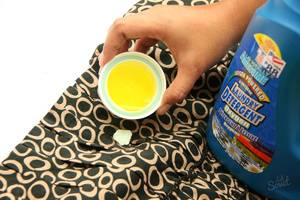 In solving such an issue as removing varnish from clothes, it is necessary to do everything correctly and in order.
In solving such an issue as removing varnish from clothes, it is necessary to do everything correctly and in order.
First, don't hesitate to clean up. The sooner you start removing the stain, the more likely you are to get rid of it.
Secondly, you need to know exactly what fabric to work with, so as not to ruin your favorite thing.
If you can't remove the stain the first time, you can try using a different product to remove it.
You should always run the test in an inconspicuous place to make sure the tissue is not damaged.
If the item is expensive or made of fabric that requires careful handling, it is better not to risk it and take it to the dry cleaner. They will surely remove any stains without damaging the material.
Useful Tips
Before doing a manicure and painting your nails, place all the necessary things conveniently on the table. If expensive clothes made of delicate and capricious fabrics are stained, have them dry cleaned.Professional formulations at the disposal of workers will better clean any contamination.
Old varnish and gel polish can be removed from thick upholstery fabric or jeans by generously smearing the area with laundry soap. Then scrape it with a knife or toothpick, and then rinse with water.
Of course, troubles can happen to anyone, but if everyday tasks are performed in home clothes, the likelihood of ruining a beautiful expensive item decreases significantly, and the ability to conveniently arrange the items that every woman needs for a good mood will avoid problems.
How and how can you remove nail polish from natural fabric clothes?
Almost all of the above cleaning methods imply the same algorithm of actions: careful removal of excess, impregnation of the affected area with the desired composition (sometimes repeatedly), fixing washing and, if necessary, removing residual stains. The difference, as a rule, lies in the effectiveness of the substance itself, the time of its action, as well as in restrictions and ancillary procedures.
 For natural fabrics, the process is approximately the same.
For natural fabrics, the process is approximately the same.
With hydrogen peroxide
Usually it is used to remove old dirt or in the case when the varnish is especially "corrosive". To do this, moisten a clean cloth or cotton swab with peroxide, gently apply it to the area of the stain and let it soak well. In severe cases, it may be necessary to clean the back of the garment.
 Peroxide can be used to remove stubborn stains.
Peroxide can be used to remove stubborn stains.
Using white spirit?
Most effective remedy for spilled gel polish: usually applied on top of the stain and left on (along with the swab) for 15 minutes. After, you need to gently wipe the treated area with a clean cloth and wash.
 White spirit works best at removing gel polish.
White spirit works best at removing gel polish.
How to remove nail polish from clothes with acetone
Since we are talking about natural fabrics, acetone can be safely used in most cases. To remove the stain, you need to apply acetone directly to the varnish. It is very convenient to do this with a pipette.
Then, using a cotton pad, carefully remove the softened varnish from the surface of the clothes.
Acetone will not harm natural fabrics.
Bleach application
Classic "Whiteness" is a very active substance, therefore it is not advisable to use it for colored and black clothes. Moreover, bleach should be used as soon as a planted spot is found, otherwise its effectiveness decreases in direct proportion to the elapsed time.
 It is advisable to use whiteness only on light-colored materials.
It is advisable to use whiteness only on light-colored materials.
As for the application, the agent is applied to the stained area, after which there is a pause (1 hour), which ends with a wash with an additional rinse.
If the stain is old
If the stain is already well dried, it is worth trying mechanical varnish removal methods. Remove varnish from textiles with sandpaper. Then a suitable solvent is used.
There is another way with soap. To remove the stain, you will need ordinary soap, preferably household soap. Soap is applied to the sponge until foam forms. Apply to the contaminated area and leave for 30 minutes. Then remove the rest of the varnish. There may be stains that can be removed with turpentine and ammonia. To do this, mix the funds in equal parts. We wash our clothes in an hour. It is advisable to use butter instead of soap.

It is possible to remove the varnish from the thing in a thermal way using an iron.
Put white paper on a flat surface, on top of it - the thing with dirt down. Run a hot iron on the inside of the garment. Replace paper as it gets dirty. Remains of varnish can be removed with acetone.
Folk ways to remove nail polish from clothes
Folk methods are varied and simple.Before giving the product to dry cleaning, try one of these methods to remove the stain.
If the stain has become embedded in your clothing and dried out, an iron will help. Heating gently leaves the varnish from the fabric.
Thermal cleaning requires an iron, white paper, or paper towel. Place the product face down on the paper, iron on the wrong side. Change the paper as it gets dirty.
After the maximum amount of varnish has been absorbed into the paper, the residues can be removed with acetone.
Petrol
- Place a cotton cloth or unnecessary towel on the wrong side of the garment.
- Apply gasoline to a cotton pad or cloth and apply to the varnish.
- Moisten the gasoline compress as it dries.
- Rub lightly as you soak.
- Replace the cotton ball with gasoline if it gets dirty.
- After the marks disappear, wash the product on your hands and then in a typewriter.
If the product is light, add crushed chalk or baby powder to the gasoline. The ingredients are mixed until mushy, applied to the dirt and left for 20 minutes. Then they wash by hand and in the washing machine.
Ethanol
Ethyl alcohol or denatured alcohol is applied to a cotton pad or cloth and gently wipe the stain from the edges to the center until it disappears. Then the product is washed.
To increase efficiency, ethyl alcohol is mixed with acetone, in a 2 to 1 ratio.
Solvent
Suitable for natural fabrics made of linen, cotton, wool. Synthetic ones can melt, change their structure or color.
- Apply solvent to a cotton swab.
- Place a cloth or paper towel on the wrong side of the garment.
- Press the solvent swab onto the varnish for 15-20 minutes.
- Then, using gentle circular motions from the edge to the center, remove the dirt.
- Then wash the product.
If the stain is old and the fabric is strong, you can first wipe the surface of the varnish with sandpaper or pick it up with a needle or toothpick. This will dissolve the varnish faster.
For maximum efficiency, the solvent is mixed with turpentine in a ratio of 1 to 1, the mixture is poured over the stain for 20-30 minutes, then sprinkled with talcum powder for 30 minutes and washed.
White Spirit
One of the most common nail polish solvents, the most gentle and most effective.
- Soak a cloth, cotton pad, or piece of gauze in white spirit.
- Apply to soiling for 10-15 minutes.
- Then gently scrub the polish particles with a brush and then with a cotton pad.
- Rinse the item with soapy water.
- Repeat the procedure if necessary.
Acetone
Slightly less gentle solvent, but just as effective. The procedure for removing stains differs little from white spirit and solvent.
- Soak a swab in acetone, apply for 20 minutes.
- Remove dirt carefully. Repeat as necessary.
- Cover acetone with talcum powder for 30 minutes before washing. Hand wash.
Hydrogen peroxide
This method is suitable for white fabrics and non-dried varnish.
- Soak a cotton wool or cloth in peroxide.
- Place a napkin or rag on the seamy side.
- Apply the compress to the stain, wait 30 minutes.
- Wash the garment with bleach.
Glycerol
Also suitable for white clothes. Glycerin at room temperature is applied to the stain, spread over the tissue with your fingers. After 20-30 minutes, the product is rinsed in soapy water. The procedure is repeated if necessary.
Another option - after applying glycerin, the item is immediately placed in warm (40 ° C) water with washing powder. After cooling, rinse. Repeat if necessary.
Can be used with gasoline or alone on thick fabrics such as denim.
It is necessary to rub the dirt well with chalk, then rinse in water and dry. If the result is unsatisfactory, repeat.
What NOT to do
- It is better not to expose a varnish stain found on a leather or suede product to solvents.
- White spirit works well with dirt, but it is quite aggressive and can cause an allergic reaction.
- Hydrogen peroxide will disrupt color saturation on brightly colored clothing.
If one method does not work, it is advisable to try another remedy.
In the case when the owner of the clothes is not sure of the correctness of the actions, it is better to take the thing to dry cleaning, protecting yourself from possible problems with damage to the product. The prices for professional processing are not so high, but in the end the result will surely be great.
The main thing is to start cleaning immediately. If a piece of fabric with varnish is still damaged during the procedures, you can sew a beautiful applique on this place, or pin a brooch.
What is not recommended?
Removing a stain is a complex and delicate process that requires a good understanding of what and when to do. Otherwise, you can completely ruin the damaged thing. Mostly not recommended:
- Delay the stain removal process. The longer the varnish stays on your clothes, the more difficult it becomes to remove over time.
- Handle aggressive and volatile liquids without protective equipment and in a poorly ventilated area.
- Carry out a pre-wash before proceeding with the removal of dirt. In this case, the temperature and washing powder will act as a fixer.
- Ignore the test application of the substance to the fabric in order to determine the negative consequences.
- Ignore the rules for treating the stain with a solvent.
- Use vinegar or citric acid.
Washing before removing the stain can cause the stain to stick.
How will gasoline help wipe nail polish off fabric?
In this case, an additional piece of cotton cloth should be placed under the clothes, preferably in several layers. Pour some gasoline on the stain and wait 20-25 minutes. After that, gently wipe off the softened varnish and, if necessary, repeat the procedure.
 Gasoline can be used to loosen varnish stains.
Gasoline can be used to loosen varnish stains.
In addition, gasoline can be used to restore whiteness in the event of a stain on light-colored clothing. For this, chalk, crushed to a powder state, is applied to the pre-moistened spot. After drying, the clothes should be washed. It is worth not forgetting that the smell of gasoline is quite persistent, so it is advisable to wash it with the addition of fragrances.
 To remove the smell of gasoline, clothes should be washed.
To remove the smell of gasoline, clothes should be washed.
Preparation
Use a cotton swab to remove the newly spilled varnish from the surface of the garment before exposing the fabric to the chemical. Already dried varnish can be removed with a toothpick or nail file.
You can remove the varnish that you accidentally dripped onto your clothes with various solvents. This means that there is a risk of dissolving the fabric dye. Therefore, before using any substance, test it. This can be done on an inconspicuous piece of fabric or on the lapel of a sleeve or collar. It is necessary to drop a liquid on a piece of matter, if its structure and color have not suffered, then this method can be applied in action.

